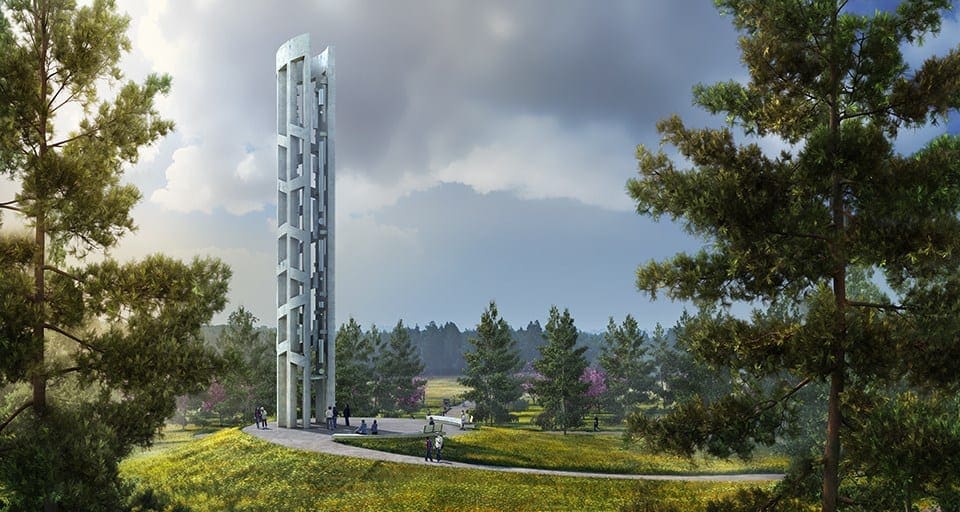Fiore to construct ‘Tower of Voices’
By: fioreMarketing | September 9, 2017 | Original Article

Originally published by the Altoona Mirror
SEP 9, 2017 | WILLIAM KIBLER, Staff Writer, bkibler@altoonamirror.com
Construction company awarded contract to build melodic device at Flight 93 Memorial
A local construction company has won a contract to build what is likely one of the world’s largest melodic devices — the final component of an iconic complex of monuments with international significance about 60 miles to the southwest.
The 93-foot Tower of Voices will function as a “monumental musical instrument,” according to a bid document published by the National Park Service, which operates the memorial site, where a plane likely intended to crash into the U.S. Capitol came down in a field after several passengers stormed the cockpit and wrestled the controls from terrorist hijackers.
“We’re honored,” said Fiore spokeswoman Shasta Langenbacher.
Fiore will be paid $3.4 million, but the company wasn’t the lowest bidder, according to the National Park Service, which operates the memorial.
The service instead awarded the contract “based on best value,” according to NPS spokeswoman Sally Mayberry. Criteria for selection included “experience, past performance, technical approach and management plan,” according to a bid document. “All evaluation factors, other than price, when combined, are significantly more important than price,” the document states.
Fiore, one of three or four bidders, submitted an extensive package detailing its relevant experience, plus additional technical information it had gathered, along with evidence of support from subcontractors, to show the park service, “yes, we know how,” Langenbacher said.
The height of the tower, which will be built of precast concrete components fabricated by Pennstress in Roaring Spring and fastened together on site, won’t be a problem for the company, Langenbacher said.
The big challenge will be ensuring the wind chimes are accurately placed, so their unique pitches are correct — as an improper anchoring or a placement too close to other chimes could lead to unwanted “reverberations,” she said.
“There’s a lot of sound engineering involved,” she added.
The company handled the bidding on the contract “like a normal job,” Langenbacher said.
“But we wanted to make sure we got everything correct,” so the firm took care to locate subcontractors and consultants with relevant knowledge, Langenbacher said.
“The worst thing would be to get the job and not be able to deliver,” she said.
The tower will stand at the park entrance, where, with the aid of its height — which contrasts with the rest of the low memorial complex — it can draw attention of those driving by on Route 30, said Paul Murdoch, the Los Angeles architect whose firm has designed the complex, which includes a plaza at the crash site, a visitors center, 40 groves of trees and a pair of walking paths.
Murdoch wanted sound to be an element in the entrance monument “because some of the last memories of people on the plane were through their voices” via cellphone conversations from the plane, Murdoch said.
The chimes, activated by wind, will produce music that is “ever-changing, (not) planned or composed,”he said.
Murdoch worked with a musician to design the tubular aluminum chimes, which operate not by banging together like the chimes on your porch, but by the action of internal strikers, each propelled by a windsail suspended from the strikers below the level of the tubes.
They are all within a two-octave range.
The musician designed them to create music with a pleasant, harmonious “consonance,” along with a bit of dissonance, Murdoch said.
“It is for all intents and purposes a musical instrument,” he said. “It’s a deceptively challenging (task).”
It may never have been done before, with so many chimes, on such a large scale, he said.
While the pitch for each chime is different, the particular chimes don’t represent particular individuals from the plane, Murdoch said.
Murdoch’s company has created full-scale mock-ups of several chimes for wind tests and has created computer extrapolations to learn what the tower should sound like, according to Murdoch.
The computer-generated recording can be heard at the “soundbreaking” at the site on Sunday.
Attendees can also activate a chime mockup, he said.
Murdoch’s firm will need to work closely with the fabricator of the chimes, when that company is chosen, he said.
The architectural firm will also need to work with Fiore to ensure all goes well, he said.
The original design for the round tower called for a vertical slot to admit the wind, but subsequent designs opened the structure to admit wind more easily from any quarter, according to Murdoch.
Still, except during storms, only some of the chimes will be sounding at any particular moment, he said.
The plans call for eight columns tied together with 40 sloped beams, with steel rebar within the beams projecting into the columns to serve as anchors.
Construction will begin in the fall, according to Langenbacher.
“It’s a huge project that means a lot to a lot of people,” Langenbacher said.
Mirror Staff Writer William Kibler is at 949-7038.
View Original Article